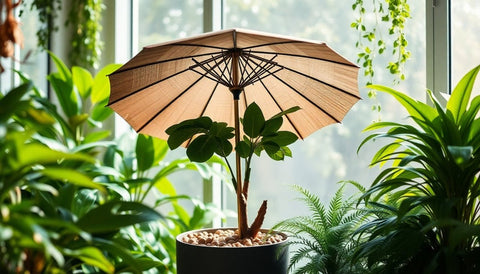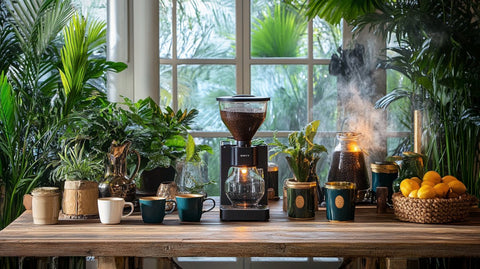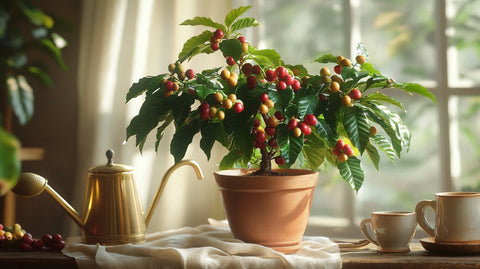The Ultimate Guide to Umbrella Tree Care
I. Introduction
The umbrella tree, also known as Schefflera, holds a special place in the hearts of houseplant enthusiasts worldwide. Picture this: you're sitting in your living room on a sunny afternoon, sipping a cup of tea, and your gaze lands on your vibrant umbrella tree, its glossy leaves swaying gently in the breeze from the open window. It's a sight that brings a sense of tranquility and satisfaction. Whether you're an experienced green thumb or new to the world of houseplants, the umbrella tree is a delightful and manageable addition to your indoor jungle.
Native to the tropical regions of Australia, Java, and New Guinea, the Schefflera's adaptability to different environments is part of why it has become a popular choice for indoor cultivation. With its striking leaf formations and substantial height potential, the umbrella tree can effortlessly enhance the aesthetic of any space. However, like all plants, it comes with its own set of unique care requirements. This guide is designed to equip you with the knowledge needed to ensure your umbrella tree thrives in your home.

II. Understanding the Umbrella Tree
A. Species Overview
The umbrella tree belongs to the family Araliaceae and is primarily known under the genera Schefflera. There are several species under this genus, but the most common as houseplants are Schefflera arboricola and Schefflera actinophylla. Each has distinctive characteristics, making them both unique additions to a plant collection. While Schefflera actinophylla can grow quite large, reaching up to 50 feet in its natural habitat, Schefflera arboricola is more compact and manageable indoors.
B. Natural Habitat
Understanding the natural habitat of umbrella trees is crucial to replicating their ideal growing conditions indoors. In the wild, these trees enjoy the warmth and humidity of tropical climates, thriving under the canopy of taller trees with filtered sunlight. This environment contributes to the development of their large, palmate leaves, which are a hallmark of their lush appearance. To ensure a healthy indoor life, we aim to mimic these conditions as closely as possible.
III. Planting and Positioning
A. Choosing the Right Location
To set your umbrella tree up for success, you must carefully consider its placement in your home. These trees flourish in bright, indirect light, making them excellent candidates for spots near east or west-facing windows. Direct sunlight can scorch their leaves, while insufficient light might lead to legginess and sparse foliage.
B. Potting Considerations

1. Soil Requirements
Umbrella trees prefer well-draining soil to prevent root rot, which can occur if the plant is left in water-saturated soil. An all-purpose potting mix that incorporates peat moss, perlite, or coarse sand can help achieve an ideal balance of moisture retention and drainage.
2. Choosing the Right Pot
The choice of pot is just as crucial as soil. Ensure that your pot has ample drainage holes to facilitate water flow and prevent waterlogging. A pot that's only an inch or two larger than the plant's root ball is ideal. Consider using decorative pots from our collection here to add a touch of style to your plant's home.
IV. Watering Guidelines
A. Frequency and Quantity
One of the most common pitfalls in umbrella tree care is overwatering. These plants are relatively drought-tolerant, so it's essential to let the top inch of soil dry out between watering sessions. Use a moisture meter or simply insert your finger into the soil to gauge moisture levels.
B. Seasonal Adjustments
Watering needs may vary with the seasons, as umbrella trees typically grow more during spring and summer and enter a semi-dormant phase in fall and winter. During the growing season, you might find yourself watering more frequently, while in the cooler months, watering can be significantly reduced.

V. Fertilizing Your Umbrella Tree
A. Fertilizer Selection
Choosing the right fertilizer is vital for promoting healthy growth in your umbrella tree. A balanced, water-soluble fertilizer with an NPK ratio of 20-20-20 is generally sufficient. Be mindful of the concentration—diluting the fertilizer to half strength generally works best to avoid any risk of over-fertilization.
B. Application Schedule
During the active growth period in spring and summer, feed your umbrella tree every four to six weeks. Come fall and winter, a single feeding every few months is more than enough. For more expert advice on nurturing your plants, explore our detailed resources at Plantology.
VI. Pruning and Maintenance
A. Pruning Techniques
Regular pruning of your umbrella tree helps maintain its shape and encourages denser growth. Use sharp, sterilized pruners to trim any leggy or overgrown branches, as well as to remove any dead or yellowing leaves.
B. Pest and Disease Management
1. Common Pests
While generally resilient, umbrella trees can attract pests like spider mites, aphids, and scale. Keeping an eye out for these pests and treating them with organic insecticidal soap can prevent infestations.
2. Disease Prevention
Root rot is a frequent issue resulting from overwatering. Ensuring proper drainage and soil moisture levels are critical steps in disease prevention. Watch for signs of root rot, such as wilting leaves or a foul smell from the soil, and act quickly to salvage affected plants.

VII. Propagating Umbrella Trees
A. Methods of Propagation
Expanding your collection of umbrella trees is an exciting adventure in horticulture. Propagation can be done using stem cuttings or air layering. Stem cuttings involve snipping a healthy stem, allowing it to dry, and then placing it in water or soil to root.
B. Step-by-Step Guide
1. Selecting a Healthy Cutting
Choose a cutting that's at least six inches long and has several leaf nodes. Cut below a node and remove any lower leaves to reduce moisture loss.
2. Rooting the Cutting
Immerse the cutting in water or directly plant it in moist soil. If using soil, cover it with a plastic bag to maintain humidity, and place it in a warm, bright location. Roots should form within a few weeks.
VIII. Embracing the Aesthetic
A. Indoor Styling Tips
When styled thoughtfully, an umbrella tree can be the perfect statement piece for any room. Pair it with complementary plants like the Agapanthus Lily of the Nile for a lush indoor garden ambiance. Consider plant stands to add height and dimension to your space.
B. Seasonal Decorations
During festive seasons, adorn your umbrella tree with eco-friendly decorations or fairy lights. This adds a touch of cheer to your home while allowing you to celebrate your love for plants all year round.

IX. Conclusion
Caring for an umbrella tree can be a rewarding experience, offering both aesthetic beauty and therapeutic benefits. Understanding its needs—from light to water, and every element in between—ensures a thriving plant and a flourishing indoor garden. We hope this expansive guide provides you with the insights needed to nurture your umbrella tree with confidence.
Don't forget, for all your plant and gardening essentials, including the elegant Adonidia Palm, visit us at Plantology. Happy Planting!
X. Troubleshooting Common Issues
A. Leaf Drop
One common issue that umbrella tree owners face is leaf drop. If your umbrella tree is shedding leaves, it's crucial to diagnose the underlying cause quickly. Environmental changes, such as moving your plant to a new location or sudden temperature fluctuations, can lead to stress, resulting in leaf drop. Ensure your plant is placed in stable conditions away from drafts, heaters, or air conditioning vents.
Overwatering or underwatering can also be the culprit. If you observe yellowing leaves before they fall, overwatering is likely at fault; ensure the soil is drying out sufficiently between waterings. If the leaves are crispy and brown before dropping, increase watering frequency gradually to prevent dehydration.
B. Yellowing Leaves
Yellowing leaves can indicate several problems, from nutrient deficiencies to poor drainage. Begin by evaluating your watering regimen— ensuring you're neither overwatering nor underwatering. If water management isn't the issue, consider feeding your plant with a balanced fertilizer to address potential nutrient shortages.
C. Stunted Growth
If your umbrella tree isn't growing as vigorously as expected, it might be due to inadequate light or nutrient levels. Move your plant to a brighter location with indirect sunlight if necessary. Additionally, examine the last time you repotted your plant; a root-bound umbrella tree may need a larger pot to thrive.

XI. Advanced Care Tips
A. Humidity Management
Umbrella trees thrive in higher humidity levels, typical of their native tropical environments. If you live in a drier climate or frequently use air conditioning, your plant may benefit from additional humidity. Consider using a humidifier in the room, or place a tray filled with water and pebbles beneath the pot, ensuring the pot's base remains above the water level to avoid root rot. Regular misting can also help maintain humidity and keep foliage looking fresh.
B. Seasonal Care Adjustments
Like many houseplants, the umbrella tree's care should be adjusted with the changing seasons. In summer, maximize light exposure while ensuring the plant doesn't overheat in direct sunlight. As winter approaches, reduce watering and avoid cold drafts which can stress the plant. If artificial heating is used, take extra measures to maintain humidity levels.
XII. Frequently Asked Questions
A. Are Umbrella Trees Toxic?
Indeed, umbrella trees contain calcium oxalate crystals, which can be toxic if ingested by pets or humans, potentially causing irritation or mouth swelling. To mitigate risks, place your plant in a location that is inaccessible to curious pets and children.
B. How Fast Do Umbrella Trees Grow?
The growth rate of an umbrella tree largely depends on environmental conditions, including light, water, and nutrients. With optimal care, umbrella trees can grow several feet annually, but inside environments with limited light may slow this pace considerably. Regular pruning ensures a manageable and aesthetically pleasing size.
XIII. Incorporating Umbrella Trees in Your Indoor Plant Collection
A. Pairing with Other Plants
Umbrella trees are versatile, complementing various indoor plants with their bold foliage and vertical stature. Consider pairing them with trailing plants like pothos or Boston ferns, which contrast well with the upright structure of the umbrella tree, creating a balanced and dynamic display.
B. Creating a Focal Point
An umbrella tree, when fully grown, can serve as a striking focal point in a room. To enhance this feature, place it solo in a corner with a bold planter or group it with smaller plants that highlight its grandeur. Additionally, lighting can play a transformative role; employing spotlights can cast intriguing shadows and accentuate its foliage at night.

XIV. Conclusion: The Joy of Growing Umbrella Trees
Mastering the care of an umbrella tree brings immense satisfaction and establishes your place among plant aficionados. As you nurture your plant, witnessing its growth and change becomes a rewarding journey, extending a piece of the tropics to your living space. The knowledge you've gained from this guide equips you to tackle any challenge in the care of your umbrella tree, emboldening your ability to foster a thriving indoor garden.
As you embrace this new green companion, remember that plant care is as much about patience and observation as it is about routine. The dynamic nature of gardening encourages continual learning and appreciation for the nuances of nature within our homes.
For further inspiration and resources, visit Plantology to explore an array of botanical wonders for your indoor oasis.
``` This continuation adds necessary details to expand the guide, covering common issues, advanced care tips, and frequently asked questions, incorporating the umbrella tree beautifully within indoor plant collections to enhance the overall guide to reach the desired word count.





























Comments (0)
There are no comments for this article. Be the first one to leave a message!